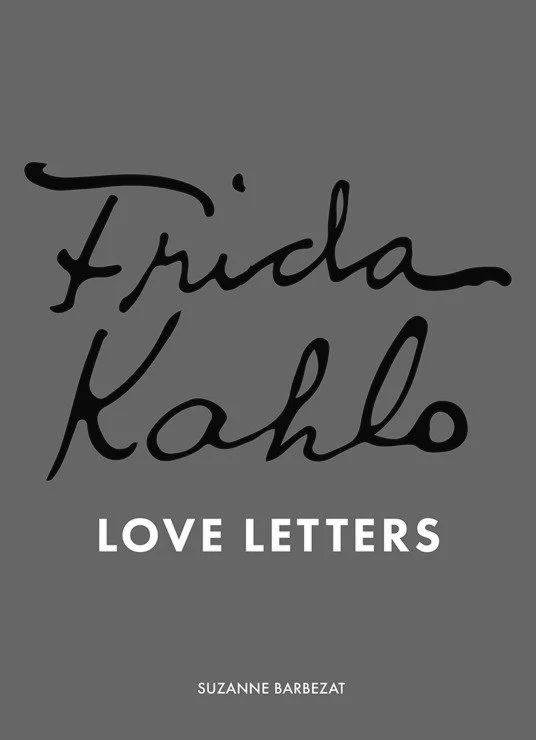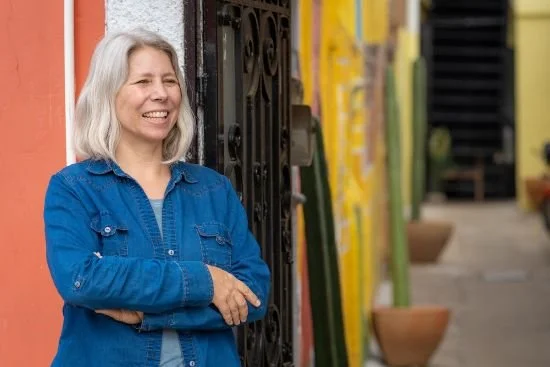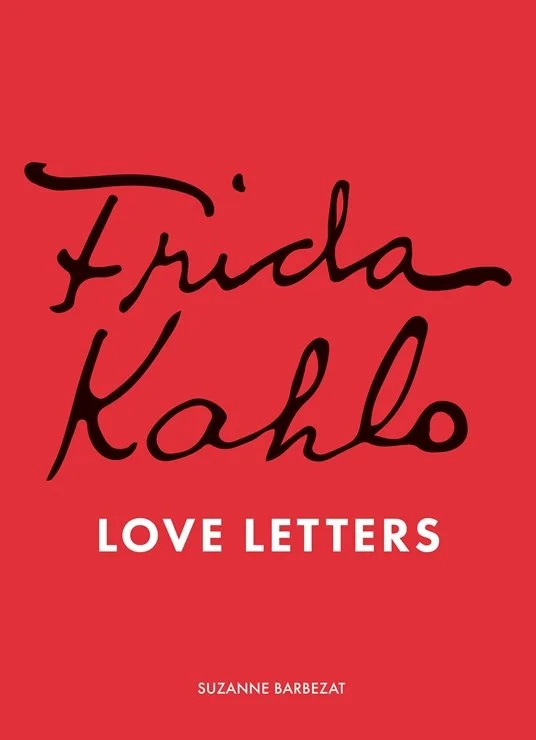Sensuality, emotional resilience, & longing for connection: Suzanne Barbezat on her book FRIDA KAHLO's LOVE LETTERS
Suzanne Barbezat
Suzanne Barbezat is a writer specializing in Mexico travel, culture and food. She is the author of Frida Kahlo at Home (Frances Lincoln, 2016), a book that explores the influence of Mexican culture and tradition, La Casa Azul and other places Frida Kahlo called home, on her life and work.
Her latest book is Frida Kahlo’s Love Letters (Frances Lincoln, 2025), which includes a selection of letters to Frida’s great loves along with translation and commentary.
Interview by Isabelle Sakelaris
How was it working in the archives at the Frida Kahlo Museum? What was the process of compiling the letters? Did you always envision separating them by recipient, or were there other versions of the manuscript?
I loved being able to consult the archives at the Frida Kahlo Museum. The first time I went stands out for me because I felt giddy and excited to get started, though I remember making a conscious effort to appear composed and professional. As I started my research, I came across a letter that Frida wrote to Diego while they were divorced and she was feeling terribly alone and heartbroken. I found myself crying as I was reading, tears streaming down my face. I experienced quite the rollercoaster of emotions that day. Overall, it was a great joy to read Frida’s letters and see her photos, and I felt very privileged to be able to engage so closely with these intimate aspects of her life.
I had a list of people she had been involved with that I wanted to include her writings to, but in some cases, there are no surviving letters (such as to Isamu Noguchi, Trotsky, and some of the women believed to have been her romantic partners). I went through and picked out letters that were representative of her relationships and in which she expressed her feelings.
I originally considered organizing the letters in chronological order, but ultimately decided that it was more interesting to examine each of her different relationships individually. I found it interesting to see the evolution of her ties, and in some cases, such as with Alejandro, it was fascinating to observe how her relationships extended across different periods of her life.
Did you have any sort of qualms about making such personal and private letters public in this book? What were they, and how did you move forward? How did you decide what to omit?
I did feel some hesitancy about making Frida’s letters public. I didn’t want to exploit or take advantage of her and her private life. She never signed up to have her life on display! I felt a responsibility to share them in a way that honors her and her legacy. Her letters reflect a remarkable depth of feeling and insight, and I believe that they deserve to be read and appreciated.
I hope that these letters will offer readers a more nuanced understanding of Frida’s life. While much attention has been given to the physical and emotional pain she endured, her experiences extended far beyond her suffering. Through her correspondence, I aim to present a fuller portrait of Frida, one that highlights the richness, complexity, and vitality of her character. I hope these letters contribute to a broader recognition of Frida as a multifaceted individual, rather than solely as a symbol of pain and resilience.
Frances Lincoln
What do you think reading Frida Kahlo’s letters, especially to her lovers, adds to the experience of viewing and understanding her artworks?
Certainly, a deeper understanding of Frida’s life can enhance the experience of engaging with her art and provide insight into what she sought to express. Her letters reveal the complexity of her emotional life and the richness of her relationships, allowing us to see her not only as an artist but as a deeply engaged human being. The sensuality, emotional resilience, and longing for connection evident in her visual work are even more palpable in her writing. This added context can enrich our interpretation of her art, encouraging us to read beyond the surface level and appreciate the interplay of passion, pain, love, and political consciousness that shaped her creative expression.
As I conducted background research on the recipients of her letters, I was struck by how compelling they were in their own right. They were artists, intellectuals, many of them active in politics. While Frida was clearly a deeply passionate and sensual person, her letters suggest that she was also drawn to intellectual connection and the exchange of ideas.
I think it’s important to note that although her work was deeply personal, it’s not purely autobiographical, and we should see it in the context of art history in general and not just her personal life. She was very politically aware, and her work often contains powerful political commentary.
I was particularly struck by her letter to Alex (October 3, 1925) shortly after the tram accident that left her bedridden for three months, which made me think of some of her self-portraits taking up themes of confinement and chronic pain. It was interesting that in the letter she was so concerned about Alex and how he was feeling at the time. Has your understanding of any of Kahlo’s artworks changed since reading these letters?
It’s interesting that you mention that, as critics of Frida Kahlo have at times characterized her as self-absorbed and overly focused on her own pain. Her letters show that she could also be caring and thoughtful. In that instance, Frida expressed concern about Alex because he had been with her in the accident (although he only sustained mild injuries) and she hadn’t yet seen him.
Frida’s health issues kept her confined to bed for long periods throughout her life. That influenced the kind of art she would create. As you say, we do find themes of pain and confinement in some of her work. And because of her physical limitations, she wasn’t able to paint murals, the common art form of many of her peers, and instead made mainly small paintings. There are the self-portraits, but also paintings made in the ex-voto style, a kind of Mexican religious folk art painting that can be seen as a prayer in the form of a painting. Also, I think of her many still lifes, a form that she was also drawn to, perhaps because she herself was forced to be still for so long. It’s interesting to see how she imbued her still life paintings with such a strong sense of sensuality, something which is also very evident in her letters to her lovers.
In the beginning of the book, Kahlo makes a few happy remarks to Alex that she’s getting better at drawing. Her attitude changes over time, particularly after a rejection from the Guggenheim Museum, which we learn about in a letter to Diego. How did you feel reading all these letters and watching her life unfold? How did your understanding of her as a person and as an artist change over the course of encountering these letters?
Like many artists, Frida’s attitude to her work and her talent fluctuated over time, often in correlation with what was happening in her life. She went through periods when she felt like she was doing good and important work, and other moments when she felt misunderstood and unappreciated. I suspect many artists experience similar ups and downs. It does make me terribly sad when I read the letters from when she was going through difficult times, doubting herself and her talent. Of course, she had no clue how appreciated she would come to be after her death.
Looking back at her life and her work, she lived such a short life (she died at 47), but her letters show how fully and passionately she lived during the time she had. I just wish she had had more time to create more art. Unfortunately, the period in which she did her best work was quite short, and that’s tragic.
In some of her later letters to Diego and Nick, Frida rages against the “intellectuals”—often people tied to the Surrealist movement—who don’t understand her work, or who call it too morbid and bloody. What do you think Frida would think or say today about the acclaim and admiration her work has received?
I think Frida would be amazed at how popular her art has become and her status as an icon. I imagine she would be thrilled to be well-known and appreciated as an artist. She would probably be frustrated by some other aspects of her fame, though, in particular, how her name and image are used for commercial purposes. Frida was deeply political and critical of capitalist systems, so she would probably see the widespread use of her face on merchandise as a betrayal of her ideals. If she had lived to see this, she would likely have resisted the flattening of her complex identity into a brand or symbol of pain without the revolutionary spirit that animated her life.
I envision that Frida would have appreciated the visibility and the serious engagement with her work and life, but she would likely have wanted to remain in control of the narrative and be understood in all her complexity: as an artist, a thinker, a political being, and a woman who defied categorization.
Check out our other recent author interviews
Isabelle Sakelaris is an art writer and aspiring poet who lives and works in New York City.
Did you like what you read here? Please support our aim of providing diverse, independent, and in-depth coverage of arts, culture, and activism.






